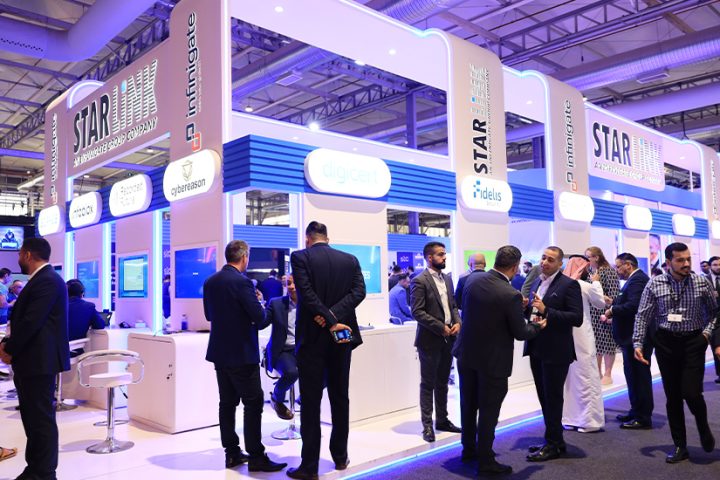Digitisation and the trend towards an ever more deeply networked world has been unbroken for more than 20 years—and is still in its early stages. Organisations that do not invest in the short term will likely fall behind in the medium term and risk not being around in the long term.
According to a Cisco VNI Report, the latest forecasts assume that the number of IP-capable end devices will double globally by 2030. One of the reasons for this is that a not inconsiderable proportion of these end devices will be integrated into the infrastructure via radio protocols such as Wi-Fi. Likewise, Wi-Fi is used to a considerable extent for data offloading from mobile data networks such as 3G, 4G and 5G, thus helping to optimise the load distribution of mobile networks in the area and in buildings. As a result, fibre has increasingly found its way into the horizontal LAN.
It is no secret that copper cables are reaching their limits when it comes to high-speed transmissions and capacities as well as lengths
It is no secret that copper cables are reaching their limits when it comes to high-speed transmissions and capacities as well as lengths. Traditional structured cabling also requires many cables in the horizontal path, leading to increased complexity. We must further consider the convergence of networks and integration of building services, which is difficult to manage over time.
Necessary network expansions and upgrades are a challenge for any operator due to ageing installations and overcrowded distribution rooms. It is therefore all the more important to design and implement a LAN concept that meets current and future requirements with minimal impact on the buildings and the daily work of the companies located there.
Necessary network expansions and upgrades are a challenge for any operator due to ageing installations and overcrowded distribution rooms
Optical fibre is the obvious solution for connecting end devices in the LAN. This can be done directly or via converters such as media converters, classic area switches, or optical network terminals in passive optical point-to-point or point-to-multipoint networks. As such, Fibre to the Edge FttE is ideal for businesses that require high capacity and flexibility in their network.
Fibre offers scalable bandwidth, low latency, and the reach and flexibility needed to meet the demands of applications such as next-generation Wi-Fi, high-availability AV, and 5G within a single building or on a large campus. The reach of fibre enables multiple devices to be connected via a single cable that extends to a common central collection point from which individual areas up to multiple floors can be served.
Like any corporate IT network, an FttE-based LAN consists of active routers, switches, and passive cables, connectors, components. Important requirements include long-reach, flexible power, and data. This must be coupled with intelligent remote-power solutions and ending rip-and-replace network planning. Let us look at these priorities in a bit more detail.
In the LAN IT architecture of a conventional company, data is transmitted either entirely via copper cable or via a combination of fibre optic backbone and copper cable up to the end device connection, which requires distribution cabinets throughout the network.
An FttE architecture is all-optical, so all data transmission is via fibre. This means that the network can be operated from a central equipment room. The main distribution frame MDF, in a form of collapsed backbone, makes intermediate distributors area distributors, floor distributors superfluous and allows the space to be used as floor space.
Centralisation and remote power supply can also have a direct positive influence on the costs for power and cooling. The extremely high bandwidth and scalability that an FttE architecture enables, in combination with Wi-Fi technologies, meet the need for modern wireless working in a flexible office environment. This also reduces the need for individual cabling and porting.
As fibre itself is unsuitable to carry the power supply of end devices, it is recommended to use composite cabling in FttE networks that contains both fibre and copper. This combines the scalability and bandwidth capacity of single-mode fibre with the power-conducting properties of copper to deliver both data and power to devices at the edge of the network.
Composite cables take up much less space than comparable copper data cables and are much better prepared than them in terms of current density, voltage drop and transmittable power, and the maximum cable length they can achieve. This simplifies future upgrades, too.
Let US take a closer look at Wi-Fi design and the requirements of enterprise customers. Currently well-established is the sixth generation of Wi-Fi. The next generation, Wi-Fi 6E, is starting to become more widely adopted and offers an extension of this standard to the 6 GHz band, significantly reducing network congestion. Wi-Fi 7 should be on the market in the next 1-2 years.
What does this mean for building owners and operators? In order to support the maximum possible data throughput of Wi-Fi 6E and Wi-Fi 7, additional cables would have to be installed. Wi-Fi 6E requires up to 10G bandwidth and Wi-Fi 7 up to 40G. The latter can be achieved with four class EA channels based on KAT6A cables with a distance limit of 90 m, or with a fibre-optic composite cable that also offers longer distances for power and data.
Another integral part of a fibre-based design, especially with composite cables, is the possibility of remote power supply. A central DC power supply offers a simple solution that can be scaled up depending on the number of devices required. The central units can also be split according to PoE requirements, overall budget and distance to the endpoint. There are many long-range solutions that can support devices at the edge of the network – in some cases even over distances of more than 600 meters.
If a device doesn’t feature a fibre input output, conversion equipment such as a media converter can change the signal from optical to electrical and connect to the device with a short copper patch cord. This is another integral part of a FttE network design, and there’s a number of cost-effective options here that can support 10G speeds and offer backward compatibility to support 1G or 2.5G speeds.
While there is still a place for copper in the networked building infrastructure, its limitations in terms of bandwidth, power density, and distance mean that networks should be designed to move the aggregation of data. Hence, the transition point from fibre to copper, and closer to the edge of the network.
By reducing the space needed for network equipment and converging multiple networks into a single, streamlined one, the impact on resources is also reduced.
Fibre offers scalable bandwidth, low latency, flexibility needed to meet the demands of applications such as next-generation Wi-Fi, high-availability AV, and 5G within a single building.














